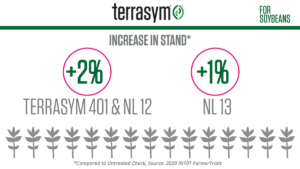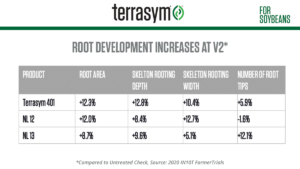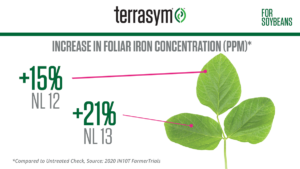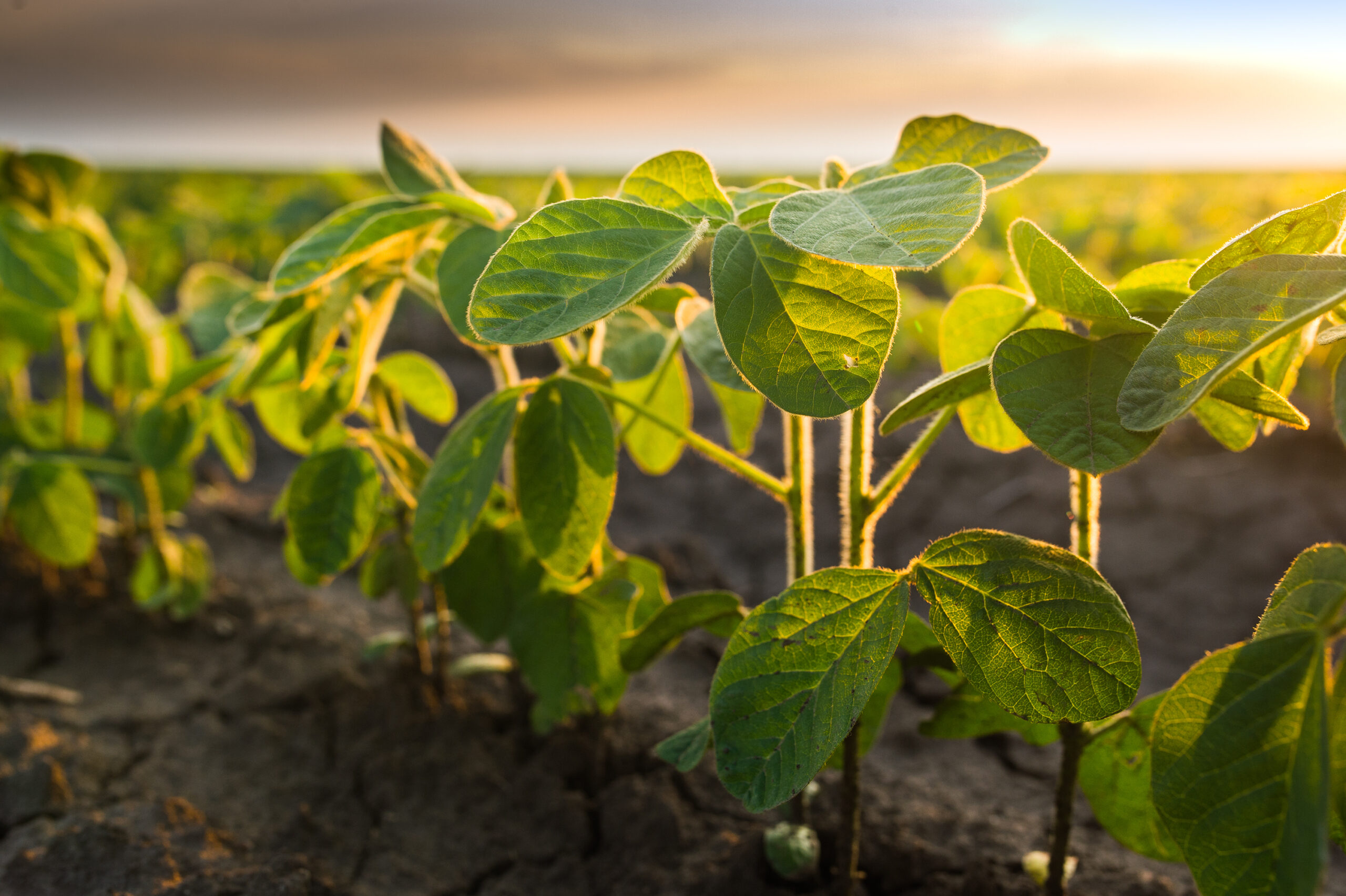We recently shared some exciting preliminary updates from our NewLeaf Technology for Corn IN10T FarmerTrials, so naturally it’s time to share insights from our early season soybean visits!

Overview & Methodology
Our soybean biostimulant FarmerTrials not only feature commercially available NewLeaf Technology 401, but also pipeline candidates NL 12 and NL 13. The ability to test our existing commercial soy biostimulant product alongside pipeline product candidates is exciting because it showcases the increasing power of our proprietary comparative genomics platform, the Prescriptive Biologics Knowledgebase™ to select high performing M-trophs out of our collection. Technical Product Lead, Dr. Allison Jack explains:
“Each evaluation of M-troph performance leads to new insights in terms of genes and pathways of interest that are associated with the desired impact on crop development and yield. Our data sciences team continues to add new analysis tools to the platform which enables our scientists to explore the complexity of our immense collection more efficiently. We are pleased to be able to share a peek into our pipeline as part of the IN10T trials”
Similarly to the NewLeaf Technology for Corn IN10T FarmerTrials, NewLeaf scientists are also expanding the vast soybean biostimulant data set with additional product evaluation via DIRT (Digital Imaging of Root Traits) software[i] and tissue sampling.
At each of NewLeaf’s 18 soybean biostimulant trial locations, stand counts and general plant measurements are taken for each treatment. Additionally, root samples are collected by IN10T field technicians who randomly select 10 plants from each treatment. These soybeans are dug up, rinsed of soil, photographed, and the images processed through the DIRT software, which returns 75 unique root architecture metrics.
Tissue sampling is also conducted by technicians selecting another 25 random plants from each treatment and removing the above-ground plant tissue to be sent to a third-party lab for nutrient analysis.
Head to our blog post featuring early season corn biostimulant trials results for more details on NewLeaf’s partnership with IN10T and the methodology behind collecting samples for DIRT.
Results
Pt. I: Enhanced Plant Stand
Stand establishment is one of the first measurements a farmer takes into account when assessing a young soybean crop, which is why NewLeaf worked with IN10T’s field technicians to ensure it was included in data collection protocols for both the first and second field visits.
“Early stand counts are an indication of plant emergence and establishment, and we’re seeing a bump in early stand counts with our soybean seed treatments,” says Manager of Field Biology, Dr. Patrick Vogan. “Getting out of the ground faster and more evenly can give the crop better resilience to early season stress.”
Even at V6, soybeans treated with NewLeaf Technology 401 were showing greater stand than the untreated check by an average of 2.5%. Pipeline strains NL 12 and NL 13 also showed average increases over the untreated check of 2.1% and 1.3% respectively.

Pt. II: Improved Root Growth
Soybeans avoid the need for fertilizer inputs due to their ability to fix their own nitrogen, which further emphasizes their need for a strong, robust root system. Inoculants and other biological products are often sold on the promise of enhanced root development. However, rarely do these products come with a data set to support that claim. Not anymore.
The trends in enhanced root developments seen in corn via assessment with DIRT software were also seen in soybean trials across all three products.

The automated image analysis capabilities of DIRT in addition to access to the computing infrastructure at the Donald Danforth Plant Science Center, NewLeaf measured a phenomenon which had been consistently observed across our screening pipeline, the enhanced development of root systems with the application of M-trophs. On average, over 18 locations, increases in total root area, skeleton rooting depth and width across NewLeaf Technology 401 and the pipeline products NL 12 and NL13 were observed.
“In addition, we observed an increase in the number of root tips for NewLeaf Technology 401 and NL 13. Since root hairs are transiently developed in the zone of elongation directly behind each root tip, and root hairs are able to acquire nutrients from the soil, we are curious to explore any possible correlations between the total number of root tips, aboveground tissue nutrients, final yield and grain quality in the final datasets,” says Dr. Allison Jack
Pt. III: Pipeline Products Showcase Potential to Combat Iron Deficiency Chlorosis
Iron deficiency chlorosis is a common, yield-limiting condition for soybeans, especially in areas with high pH soils. With an estimated 1.8 million at-risk acres across the North Central US and annual income loss exceeding $100 million, finding a solution to this yield-robber has become increasingly important in recent years. [ii]
When NewLeaf scientists discovered a 7.7% increase in foliar iron content in with NewLeaf Technology 401 during a 2019 greenhouse screening, they knew testing this technology across broad acres with the IN10T partnership would be paramount.
While NewLeaf Technology 401 did not show significant increases in iron across geographies, both pipeline strains NL 12 and NL 13 showcased 15.6% and 21.1% increases respectively. As soybean production increases in vulnerable regions, these pipeline M-trophs showcase a unique, cost effective opportunity to combat this threat.

Seeing trends from scientific discovery extend across geographies in real-world farming conditions with the IN10T trials continues to strengthen the value proposition M-trophs bring to agriculture today. And even as the growing season comes to a close with combines beginning to roll in the field the data analysis is far from over.
Keep following NewLeaf Technology throughout the year as we continue to evaluate how M-trophs strengthen both crops and yields in fields near you!
[i] Das, Abhiram, Hannah Schneider, James Burridge, Ana Karine Martinez Ascanio, Tobias Wojciechowski, Christopher N. Topp, Jonathan P. Lynch, Joshua S. Weitz, and Alexander Bucksch. 2015. “Digital Imaging of Root Traits (DIRT): A High-Throughput Computing and Collaboration Platform for Field-Based Root Phenomics.” Plant Methods 11 (1): 51. https://doi.org/10.1186/s13007-015-0093-3.
[ii] Hansen, N. C., V. D. Jolley, S. L. Naeve, and R. J. Goos. 2004. “Iron Deficiency of Soybean in the North Central U.S. and Associated Soil Properties.” Soil Science and Plant Nutrition 50 (7): 983–87. https://doi.org/10.1080/00380768.2004.10408564.



